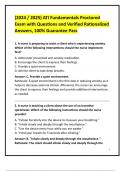Exam (elaborations)
(2024 / 2025) ATI Fundamentals Proctored Exam (3 Different Version Exam) with Questions and Verified Rationalized Answers, 100% Guarantee Pass (best answers)
- Course
- Institution
(2024 / 2025) ATI Fundamentals Proctored Exam (3 Different Version Exam) with Questions and Verified Rationalized Answers, 100% Guarantee Pass (best answers)
[Show more]



